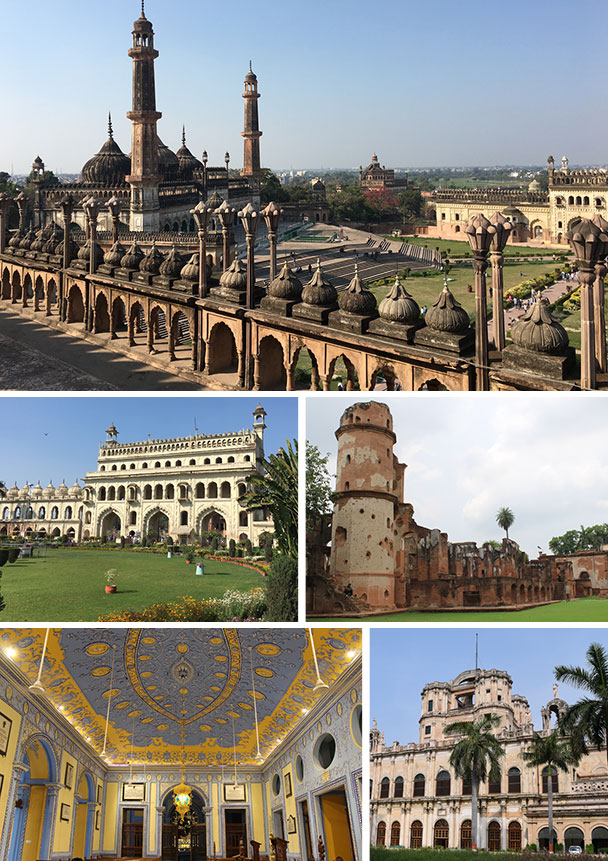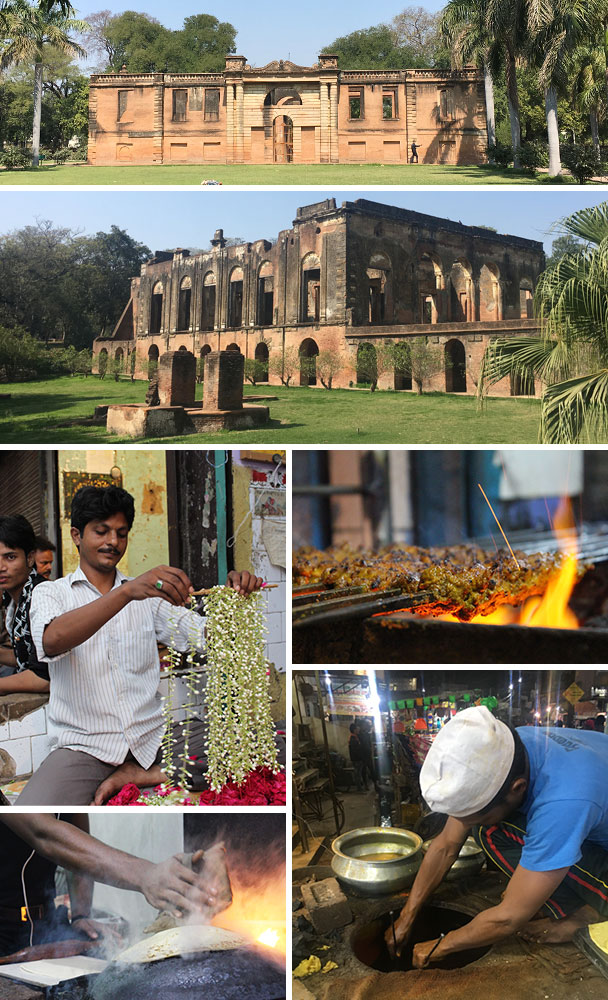April 1, 2020

Treat 1: Lucknow: a city of ancient grandeur, the Indian Mutiny and some of the best street food ever and which is definitely off the main tourist circuit.
Whilst the Maharajas of Rajasthan established a form of entente with the British Raj, thereby retaining their palaces and a degree of independence, many other rulers of India such as the Nawabs of Lucknow were forced to sign a succession of treaties which annexed much of their kingdoms and greatly reduced their power.
In its 18th-century heyday Lucknow was far more cultured than the Mughal city of Delhi, which at that time was in decline. Indeed, one historian has described Lucknow as an Indian version of Monte Carlo, Las Vegas and pre-revolution Iran with just a touch of Glyndebourne thrown in for good measure….
Last year at the behest of a local tour company I found myself having supper at La Martinière, a large private school founded by General Claude Martin in 1854. This enterprising soldier, philanthropist, architect, banker, art collector and educationalist built the property, also called Constantia, in memory of his paramour Constance. Zoffany painted here, and the school possesses one particularly fine example of his work called Boulone Lisa.
The next day I met the guide who was to give me a speedy tour of the historical highlights of the city; a bright, earnest chap albeit slightly anxious with threadbare clothes like a Dickensian clerk — and very keen to impress. He explained that during the 18th century many members of the East India Company married Indian noblewomen and mixed happily with Indian society, but that by the end of the century Governor General Wellesley had imposed a much stricter regime, alienating many Indians.
By the Victorian era the noose of empire and a sense of propriety rooted in evangelical Christianity had altered things for the worse in the delicate balance of Indo-British relations, setting the scene for the infamous siege of the British Residency in 1857. One of the catalysts for the first war of independence as it is sometimes known was the sepoys’ disgust and horror that the grease used to ease bullets into their new Enfield rifles was allegedly made of either pork or beef fat. This was of course deeply offensive to both Muslims and Hindus.
The five-month siege took its toll on both sides, and conditions inside the complex were horrific, many soldiers and civilians dying from cholera. The neoclassical buildings have been left in ruin as a testimony to the devastation and suffering inflicted. The site surrounded by mature trees is remarkably peaceful – an oasis of calm in a busy city.
You can clearly discern the forlorn remains of a staircase leading up to a grand first-floor ballroom and a chimneypiece hanging midair. This was the only building in the empire where the Union Flag was never lowered until Independence. It became a shrine to imperial India and a symbol of the Englishmen’s stiff upper lip in adversity — or perhaps the arrogance that got them there in the first place. Whatever your opinion, the site is worthy of a visit as indeed are many other important buildings in the city. There is even an imitation Taj Mahal, although the real thing is only a few hours’ drive away.

The street food of Lucknow, influenced by the Persian cuisine of the Mogul emperors, is outstanding, and there are no fewer than fifty-five varieties of kebab with different breads to accompany each one. In one modest-looking local eatery some melt-in-your-mouth water buffalo meat was sizzling in the pan at one moment and on my plate at the next: a dish named Tunde ke Kabab, originally created for a toothless nawab — or so the story goes. Bread is speedily made by a production line of six men squatting in a circle around an open-fronted oven. It was fascinating to watch and fantastic to be in a place one would never dream of entering without a local guide.
Why not include Lucknow on your next visit to India and follow the road less travelled?
Lucknow fits in well with a journey to Varanasi, Khajuraho and the tiger reserves further south.
Pictures courtesy of Tornos and Miles.
NB prices shown were current at the time of writing the newsletter and are not necessarily current now.
Please ask for an updated quote.
- The Khajuraho temple complex, a Unesco World Heritage Site
- A Sense of Place: Poignancy in KwaZulu Natal
- A Sense of Place: Northern Botswana
- A Trio of Treats in India
- And now for something completely off grid and different: AFRICA’S ULTIMATE RAINFOREST SAFARI
- A Trio of Treats off the beaten track – We get you to places that others don’t!
- A Trio of Treats On The Rift Valley
- A Sense of Place – Can the muppets save a species?
- Trio of treats (Rajasthan, Maldives and Garden Route)
- A Sense of Place – A favourite place: Tanzania and Ruaha
- A Sense of Place – A favourite place in Botswana: the Okavango with elephants galore
- A Sense of Place – Here be dragons and a dark past
- A Sense of Place – Justice Regained
- A Sense of Place – Summer rains make the roads impassable
- A Sense of Place – ‘Those two ladies put light in my future.’
- A Sense of Place – The bird who lost its nest
- A Sense of Place – Talking with the Maasai
- Newsflash: first American guests to Tanzania since March 2020
- A Sense of Place – AFRICA NEEDS YOU
- Escape to Italy?
- Covid: the road still to be travelled.
- A trio of treats. Series of 3 (Part 3): Tiger reserves.
- A trio of treats. Series of 3 (Part 2): Khajuraho.
- A trio of treats. Series of 3 (Part 1): Lucknow.
- A Sense of Place – Engaged people may save the planet
- A word on lions and a trio of treats
- A Sense of Place – India’s most holy city
- A wealth of wilderness walks in Namibia
- Travel snippets from Miles
- A trio of treats on the green island of Pemba in the Zanzibar archipelago
- A Sense of Place – THE INSIDE TRACK on Cape Town guiding
- A Sense of Place – Migrations of people and beasts: East Africa
- A Sense of Place – An era of revolution and global alliances
- A Sense of Place – A walk on the wild side
- A Sense of Place – The ghost ingredient is back
- A Sense of Place – Liuwa Plains and Kafue National Parks – Zambia
- A Sense of Place – Literati in the Pink City, the Capital of Rajasthan
- A Sense of Place – A Tamil town still connected to Europe, Art Deco architecture, and temple antiquity in Southern India.
- A Sense of Place – Dreamy aquamarine sea and stunning safari with the Makuleke people
- A Sense of Place – A trio of lovely ladies in Hyderabad
- A Sense of Place – Entamanu, the wishing tree and walking with the Hadza tribe.
- We get you to places that others don’t… St Helena, Gt Zimbabwe ruins and Papua new Guinea
- A Sense of Place – Walking in the hippie hills of the Himalayas
- A Sense of Place – The Okavango: the river that never finds the sea
- A Sense of Place – The Great Rift Valley, Laikipia, Samburu warriors and Maasai Olympics.
- A Sense of Place – Escape the world in the Namib Desert
- Africa is a massive continent: a collection of 55 countries
- A Sense of Place – Zambezi Watery Wilderness
- A Sense of Place – Burma: the road beyond Mandalay
- Lake Malawi – Would you rather pay for the advertising or the experience?
- From shoe-shine boy to tourist guide in Ethiopia
- A Sense of Place – Ladakh, the Himalayas
- Dhow sailing, Lions are back in Malawi, Self-drive in Namibia
- Sacred rivers and forts, India
- Piranhas, sting rays, caimans – and still people go into the River Negro!
- Kerala, Southern India – God’s own country
- South Africa: Crucible of the rainbow nation
- Madagascar: croissants and lemurs
- Argentina vs Africa on wildlife drama
- Uganda – Gorillas and Gardens
- Mozambique & Kenya: immigration official on holiday
- Mozambique: Gorongosa and reconciliation in the bush
- Zimbabwe is ready for Tourists again
- Serengeti ecosystem and unbeatable savannah
- Lamu: crab complaining
- Kenya: circumcision
- Zambia: Ellie rescue
- Africans: always smiling
- Tswalu
- French sketch
- Kenya: the best hosts
- First visit to Africa 1986
- Namibia, Namib Rand, Skeleton Coast and the ultimate flying safari
- A few gems off the beaten track: Fanjove Island, Tanzania; The Singular Hotel, Patagonia and Isla Palenque, Panama.
- Elephant relocation, quad bike expedition and new Sossusvlei reserve
- Templed out in Tamil Nadu and elephant refuge in Jaipur
- Kenyan sanctuary and family run camp in Zambia
- Australia: Arkaba, Tasmania and Lord Howe Island
- Australia: in the outback and off the beaten track
- India: heavenly Himalayan hideaways, Botswana: fun safari for children and Argentina: hidden homestay in a mountain desert
- Limpopo retreat, Serengeti spectacle and adventure on the Zambezi
- Value for money in Kenya and the trail less travelled in Peru
- Lions in danger, free nights and a new coastal gem
- G and T on demand, hidden beach, micro-light and sleeping on a dam
- Off the beaten track